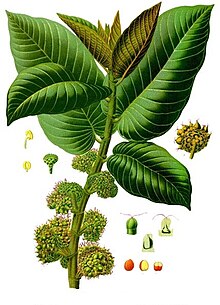Moraceae
| Moraceae | |
|---|---|

| |
| (Castilla elastica) | |
| Sayantipiko na klasipikasyon | |
| Kahadean: | Plantae |
| Klado: | Angiosperms |
| Klado: | Eudicots |
| Klado: | Core eudicots |
| Klado: | Rosids |
| Orden: | Rosales |
| Pamilya: | Moraceae Gaudich.[1] |
| Genera | |
|
Hilingon an teksto | |
AnMoraceae— o inaapod man namulberry familyofig family— sarong pamilya kan tanom nanagbuburakbinubuo kan 38 genera asin lampas sa 1100 na espesye.[2]Kadaklan nakalakop sa tropikal asin subtropikal na mga rehiyon, igwa man nin dikit sa mga temperadong klima. Ansynapomorphysa laog kan Moraceae iyo an presensiya kan mgalaticiferasin malagatas nasapsa buongparenchymatous na tisyu,sa kagabsan, an katangian kaini iyo an pagkakaigwa nin duwangcarpelso paminsan saro lang, surumpayan na mgaburak,asin surumpayan na mgabunga.[3]Sa pamilyang ini nakaayon an mga bistong tanom arog kanBalete,banyan,breadfruit,mulberry,asinOsage orange.An mga burak kan Moraceae madalaspseudanthia(o minsaninflorescence).

Historical taxonomy
[baguhon|baguhon an source]Dati kasali sa order naUrticales,an mga bagong pag-adal an nagkaag kani sa order kanRosalessa clade na inaapod na urticalean rosids igdi kasali man anUlmaceae,Celtidaceae,Cannabaceae,asinUrticaceae.Cecropia,na ikinaraag sa Moraceae, Urticaceae, o sa sadiri nindang pamilya, an Cecropiaceae, kaayon na sa Urticaceae.[4]
AnDioecy(mga indibiduwal na magkasuway an kasarian) nagluluwas na may primitibong estado sa Moraceae.[5]
Distribusyon
[baguhon|baguhon an source]An mga Moraceae pwedeng mahiling sain man na parte kan kinaban, pinaghihinalaan dahil sa pagsuruwayan kanGondwanasa panahon kanJurassic[6].An kadaklan kan espesye mahihiling sa lumang tropiko na igwang doon sa Asia asin mga pulo sa Pasipiko.[7]
Phylogenyo
[baguhon|baguhon an source]An modernongmolecular phylogeneticsitinutugma an mga relasyon na ini:[4][5][8][9]
|
| ||||||||||||||||||||||||||||||||||||||||||||||||||||||||||||||||||||||||||||||||||||||||||||||||||||||||||||||||||||||||||||||||||||||||||||||||||||||||||||||||||||||||||||||||||||||||||||||||||||||||||
Mga tribo asin genera
[baguhon|baguhon an source]An Moraceae binubuo kan:[10]
- ArtocarpeaeLam. & DC. 1806
- ArtocarpusJ.R.Forst. & G.Forst.(~50 spp.)
- BatocarpusH.Karst.(4 spp.)
- ClarisiaRuiz & Pav.(3 spp.)
- HullettiaKing ex Hook.f.(2 spp.)
- ParartocarpusBaill.(3 spp.)
- PraineaKing ex Hook.f.(4 spp.)
- TreculiaDecne. ex Trécul(3 spp.)
- CastilleaeC.C.Berg 1977
- Antiaropsineae(C.C.Berg) Clement & Weiblen 2005
- AntiaropsisK.Schum.(1 sp.)
- SparattosyceBur.(1 sp.)
- CastillineaeClement & Weiblen 2009
- AntiarisLesch.(1 sp.)
- CastillaCerv.(3 spp.)
- HelicostylisTrécul(7 spp.)
- MaquiraAubl.(5 spp.)
- MesogyneEngl.(1 sp.)
- NaucleopsisMiq.(~20 spp.)
- PerebeaAubl.(9 spp.)
- PoulseniaEggers(1 sp.)
- PseudolmediaTrécul(~9 spp.)
- Antiaropsineae(C.C.Berg) Clement & Weiblen 2005
- DorstenieaeDumort. 1830
- BleekrodeaBlume(3 spp.)
- BosqueiopsisDe Wild. & T.Durand(1 sp.)
- BrosimumSw.(13 spp.)
- BroussonetiaL’Hér. ex Vent.(8 spp.)
- DorsteniaL.(~105 spp.)
- FatouaGaudich.(3 spp.)
- HelianthostylisBaill.(2 spp.)
- MalaisiaBlanco 1837(1 sp.)
- ScyphosyceBaill.(2 spp.)
- SloetiaTeijsm. & Binn. ex Kurz 1864(1 sp.)
- TrilepisiumThouars(1 sp.)
- TrymatococcusPoepp. & Endl.(2 spp.)
- UtsetelaPellegr.(1 sp.)
- FiceaeGaudich. 1830
- FicusL.(750 spp.)
- MaclureaeW.L. Clement & Weiblen 2009
- MacluraNutt.(11 spp.)
- MoreaeDumort. 1829
- Fossils
Toltolan
[baguhon|baguhon an source]- ↑Angiosperm Phylogeny Group (2009). "An update of the Angiosperm Phylogeny Group classification for the orders and families of flowering plants: APG III"(PDF).Botanical Journal of the Linnean Society161(2): 105–121.doi:.http://onlinelibrary.wiley /doi/10.1046/j.1095-8339.2003.t01-1-00158.x/pdf.Retrieved on 2013-07-06.
- ↑Christenhusz, M. J. M.; Byng, J. W. (2016). "The number of known plants species in the world and its annual increase".Phytotaxa261(3): 201–217.doi:.http://biotaxa.org/Phytotaxa/article/download/phytotaxa.261.3.1/20598.
- ↑Judd WS, Campbell CS, Kellogg EA, Stevens PF, Donoghue MJ (2008).Plant Systematics: A Phylogenetic Approach.Sunderland, MA: Sinauer Associates, Inc. pp. 1–620.ISBN978-0-878-93407-2.
- ↑4.04.1"Urticalean rosids: Circumscription, rosid ancestry, and phylogenetics based onrbcL,trnL–F,andndhFsequences".American Journal of Botany89(9): 1531–1546. 2002.doi:.PMID 21665755.http:// bricol.net/research/CICphylog/CICfinalSTUFF/Urtical-rosids.pdf.
- ↑5.05.1"On the origin of the fig: Phylogenetic relationships of Moraceae fromndhFsequences".American Journal of Botany91(5): 767–777. 2004.doi:.PMID 21653431.Archived fromthe originalon 2021-02-13.https://web.archive.org/web/20210213101207/https://bsapubs.onlinelibrary.wiley /journal/15372197.Retrieved on 2019-09-09.
- ↑Plantilya:Cite website
- ↑Zerega NJC, Clement WL, Datwyler SL, Weiblen GD. "(2005)." Biogeography and Divergence times in the mulberry family (Moraceae) ".Molecular Phylogenetics and Evolution37(2): 402–416.doi:.PMID 16112884.
- ↑"Morphological evolution in the mulberry family (Moraceae)".Systematic Botany34(3): 530–552. 2009.doi:.http:// ingentaconnect /content/aspt/sb/2009/00000034/00000003/art00010.
- ↑"Biogeography and divergence times in the mulberry family (Moraceae)".Molecular Phylogenetics and Evolution37(2): 402–416. 2005.doi:.PMID 16112884.
- ↑Hepworth C. (2018). "Moraceae - The Mulberry Family".Florida Fruit Geek.https://floridafruitgeek /moraceae-the-mulberry-family/.
